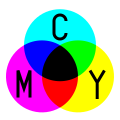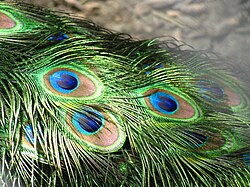Color
Color (or colour in Commonwealth English; see spelling differences) is a property of light.
The following are the most common color names:
Primary colors can be mixed to make other colors. Red, yellow, and blue are the three traditional primary colors. The primary colors for television screens and computer monitors are red, green and blue. Printers and paints use magenta, yellow, and cyan as their primary colors; they may also use black. Sometimes this set of colors is simply called red, yellow, and blue.
People who can not see colors or have a distorted sense of color are called color-blind. Most color-blind people are male.
Colors are sometimes added to food. Food coloring is used to color food, but some foods have natural colorings, like beta carotene.
When something has no color, it is called transparent. An example is air.
The science of color is sometimes called chromatics, colorimetry, or simply color science.
A translucent material is not the same as a colorless material because it can still have a color, such as stained glass.
Color Media
The visible spectrum perceived from 390 to 710 nm wavelength
The upper disk and the lower disk have exactly the same objective color, and are in identical gray surroundings; based on context differences, humans perceive the squares as having different reflectances, and may interpret the colors as different color categories; see checker shadow illusion
Normalized typical human cone cell responses (S, M, and L types) to monochromatic spectral stimuli
The visual dorsal stream (green) and ventral stream (purple) are shown; the ventral stream is responsible for color perception
Optimal color solid or Rösch–MacAdam color solid (with D65 white point) plotted within CIE 1931 XYZ color space. Notice the central symmetry of the solid, and the two sharp edges, one with warm colors and the other one with cool colors.
The visible gamut plotted within the CIELUV color space using D65 whitepoint. u and v are the horizontal axes; L is the vertical axis.










